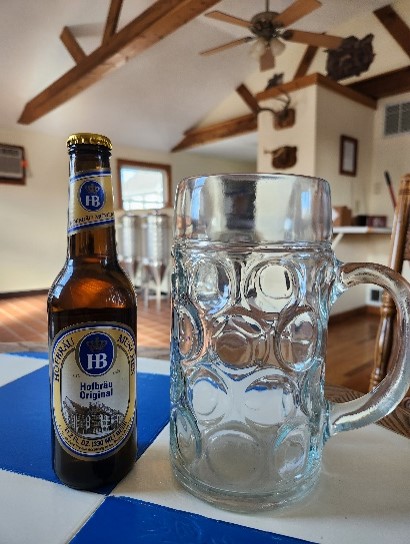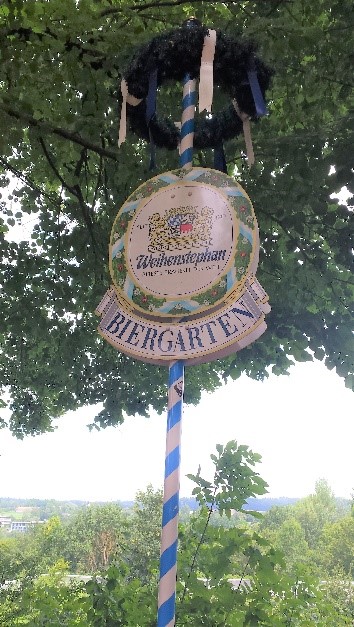Intro to Bavarian Beers
03/17/2023
By A. Dustin Gunter

A Maß is the typical serving glass for a Munich Helles and Dunkel
When hiking through a pristine forest, you come to a clearing. Your immediate view is of a small village with pastel-colored buildings amongst the rolling bucolic countryside. In the background you see the blue silhouette of the Alps standing resolute as they have for millennia. At this moment, you know there’s only one place you could be, Bavaria.
Bavaria is not only blessed with some of the most breathtaking landscapes in the world, but it is also fortunate to be the home of some of the world’s most enjoyable beers. There are a wide variety of beer styles native to Germany’s largest state, from Märzen to Maibock to Rauchbier, but for this article, we’ll share a topline view of the big three, Helles (bright), Dunkel (dark), and Weiß (“white” in German, wheat beer in Bavaria). One can typically find any or all three of these styles on any menu throughout Bavaria and each is able to be recreated with simple ingredients found at almost all homebrew shops.
The first beer on that menu is a Helles, or 4A-Munich Helles from the BJCP style guide. This beer is as approachable as it gets when it comes to Bavarian brews and is the king of the beer garden. This bottom fermenting lager is clean, smooth, and malt forward with a delicate hop character that has just enough bitterness to balance out the sweetness from the malt. A typical Helles has a pale straw yellow color and is crystal clear making it exceptionally drinkable, especially being served in one liter glass mugs called a Maß. Ingredients typically consist of German pils malt, a small percentage of dextrin malt, and German noble hops. Because of the simplicity of ingredients and need for cold storage, any flaw in this beer is usually perceptible, which makes this a difficult style to recreate with perfection. Nevertheless, brewing a Helles is a worthwhile pursuit for anyone trying to create the perfect sense of contentment and conviviality that comes with a Bavarian beer hall.
Going down the menu we come to the humble and often overlooked Dunkel. Though Dunkel simply means “dark” in German, ordering a Dunkel, or 8A-Munich Dunkel from the BJCP style guide, in Bavaria will result in the customer receiving an exceptionally approachable brown lager served in the same style glass mug as a Helles. This beer is rich in malt flavors without being cloying, toasty without being astringent, and hopped just enough to balance out the profile. Munich malts, as well as German Pils, create the malty backbone of a Dunkel with typical German hop varieties used to bitter. This beer has cousins all over the continent, from the Czech Dark Lager to Schwarzbier, but others don’t hold a candle to the superbly smooth and quenching effect that comes from the Dunkel.
Our final listing on the menu is Weiß, or 10A-Weissbier. Because this beer is an ale, it makes for a great first venture into the world of Bavarian beer styles as it does not require any cold storage for fermentation control. Weiß is used interchangeably with Weissbier, Hefeweizen, or simply Weizen, and is a historical anomaly in the lager dominated Bavarian beer landscape. Considered by many to be the Champagne of the Bavarian people, a Weiß is a lightly hopped German ale with notes of banana and clove from the fermentation profile. This beer is typically served in a tall glass that tapers as it hits the base. Like the Helles, this beer is a pale straw yellow color, but can have a perceptible haze from the residual yeast, hence “Hefe” which means yeast. Some haze may also be attributed to the high quantity (at least 50%) of wheat in the grain bill, the rest of the grain bill being made up of lightly kilned German malt, with typical German hops to bitter. Weissbier can also be mixed with lemon soda and is a popular drink with cyclists or “Radler” in German. With its lingering head and higher than usual effervescence, a Weiß is analogous to the people who make it and mixes perfectly with a warm summer day.

The Weihenstephan Brewery is known as the world’s oldest and has tremendous Weissbier.
Of course, we’ve just scratched the surface of what Bavarian beer has to offer. Each style could have its own write up dedicated to history, ingredients, as well as brewing and fermentation techniques. For now, whether you’re under the cool shade of a beer garden or at your local bar with a friend, raise one for Bavarian beers and the people who make them. Auf wiedersehen und Prost!
Related Products
All contents copyright 2024 by MoreFlavor Inc. All rights reserved. No part of this document or the related files may be reproduced or transmitted in any form, by any means (electronic, photocopying, recording, or otherwise) without the prior written permission of the publisher.

